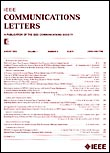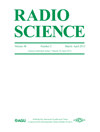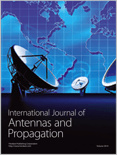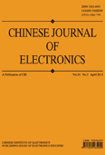
Radioengineering
Scope & Guideline
Empowering innovation in electrical and electronic engineering.
Introduction
Aims and Scopes
- Signal Processing Techniques:
Research focusing on advanced signal processing algorithms and methods, including techniques for target detection, tracking, and classification in various environments, such as urban, underground, and underwater. - Communication Systems:
Studies on the design, optimization, and performance analysis of communication systems, particularly in the context of emerging technologies like 5G, UAV communications, and IoT networks. - Antennas and Propagation:
Innovative designs and applications of antennas, including miniaturization, polarization diversity, and multi-band capabilities to meet the requirements of modern wireless communication. - Machine Learning Applications:
Integration of machine learning and artificial intelligence in radio engineering, focusing on applications like spectrum prediction, intrusion detection, and classification in communication networks. - Electromagnetic Compatibility and Interference:
Research addressing issues related to electromagnetic interference, compatibility, and mitigation strategies, particularly in complex environments involving multiple signals. - Power Amplifiers and Filters:
Development and analysis of RF power amplifiers and filters, emphasizing linearization techniques and performance optimization for various applications. - Wireless Sensor Networks:
Exploration of methodologies for the efficient design and operation of wireless sensor networks, including energy harvesting and data gathering strategies.
Trending and Emerging
- Machine Learning and AI Integration:
There is a rising trend in the application of machine learning and artificial intelligence techniques for improving communication systems, signal processing, and data analysis, indicating a shift towards smarter technologies. - UAV and Drone Communications:
Research focusing on UAV-assisted communication networks is gaining momentum, reflecting the increasing importance of unmanned aerial vehicles in modern communication infrastructure. - 5G and Beyond Technologies:
The exploration of technologies related to 5G and future communication systems is a prominent theme, showcasing the journal's commitment to addressing the challenges and opportunities presented by next-generation networks. - Internet of Things (IoT) Security and Optimization:
As IoT devices proliferate, there is a growing emphasis on security measures and optimization strategies for IoT networks, highlighting the need for robust and efficient communication solutions. - Advanced Antenna Technologies:
Innovations in antenna design, particularly those involving metamaterials and multi-functional capabilities, are trending, driven by the demand for enhanced performance in diverse applications.
Declining or Waning
- Traditional RF Circuit Design:
There has been a noticeable reduction in publications focusing on traditional RF circuit design principles, as the field increasingly shifts towards integrated and software-defined approaches. - Basic Antenna Theory:
Research centered on basic principles of antenna theory is declining, possibly due to the transition towards more complex and application-specific designs that leverage modern computational methods. - Analog Signal Processing:
The focus on analog signal processing techniques is waning, with a significant shift towards digital processing methods that offer greater flexibility and efficiency in modern applications. - Conventional Radio Frequency Identification (RFID) Systems:
Publications discussing conventional RFID systems are decreasing, likely as attention moves towards more advanced applications and integrated systems involving IoT. - Single-Modal Communication Systems:
Research on single-modal communication systems is becoming less prominent, as there is a growing emphasis on multi-modal and hybrid systems that leverage various technologies for improved performance.
Similar Journals

Journal of Electrical Engineering & Technology
Exploring Technological Breakthroughs in ElectronicsJournal of Electrical Engineering & Technology is a prominent academic journal published by SPRINGER SINGAPORE PTE LTD, dedicated to advancing the field of Electrical and Electronic Engineering. With an established history since 2008, the journal has become a vital resource for professionals, researchers, and students seeking to explore innovative research and technological developments within the discipline. The journal boasts a commendable 2023 Scopus Rank of #334 out of 797 in its category, reflecting its quality and the impact of published works. As a Q2 category journal, it upholds rigorous peer-review standards, making it a credible platform for disseminating groundbreaking findings. While currently not an open-access publication, the journal ensures that its content is accessible to a global audience committed to knowledge enhancement and technological progress. Subscribe or access issues through institutional affiliations to stay at the forefront of advancements in electrical engineering.

Progress in Electromagnetics Research M
Unveiling the Potential of Electromagnetic TechnologiesProgress in Electromagnetics Research M is a prominent journal published by ELECTROMAGNETICS ACADEMY, dedicated to advancing the field of electromagnetics through innovative research, theoretical exploration, and practical applications. With a focus on condensed matter physics and electronic, optical, and magnetic materials, this journal serves as a vital platform for scholars and practitioners seeking to disseminate new findings and methodologies. While it currently holds a Q3 ranking in both aforementioned fields, it offers a valuable contribution to the understanding and development of contemporary technologies. The journal's ISSN is N/A, but its E-ISSN is 1937-8726, ensuring that research is accessible to a global audience. Progress in Electromagnetics Research M aims to foster collaboration and knowledge sharing among researchers, making it an essential resource for anyone interested in the dynamic and evolving area of electromagnetics.

IEEE COMMUNICATIONS LETTERS
Transforming Research into Impactful TechnologiesIEEE Communications Letters, published by the esteemed IEEE - Institute of Electrical and Electronics Engineers, is a leading journal in the fields of Computer Science Applications, Electrical and Electronic Engineering, and Modeling and Simulation. Since its inception in 1997 and continuing through to 2024, this journal has consistently ranked in the prestigious Q1 quartile across its categories, reflecting its high quality and substantial impact in the academic community. With an impressive Scopus rank, particularly standing at #24 in Mathematics - Modeling and Simulation, the journal serves as an essential resource for researchers, professionals, and students eager to stay at the forefront of innovative communications technologies. Although it does not offer open access, the journal ensures rigorous peer review and publication of concise, impactful articles that push the boundaries of research and application. Whether you’re involved in theoretical developments or practical implementations, IEEE Communications Letters provides critical insights that shape the future of engineering and technology.

RADIO SCIENCE
Advancing Electromagnetic FrontiersRADIO SCIENCE, published by the American Geophysical Union, is a premier journal dedicated to advancing the field of electromagnetic research across various domains, including Earth and planetary sciences, electrical engineering, and condensed matter physics. With an impressive convergence of scholarly contributions from 1966 to 2024, the journal is recognized for its impactful research, reflected in its Scopus rankings and its Q2 quartile status across multiple relevant categories. It ranks 71st in general Earth and planetary sciences and 396th in electrical and electronic engineering, highlighting its broad reach and significance. Although not an Open Access journal, RADIO SCIENCE continues to engage a dedicated readership of researchers, professionals, and students eager to contribute to and benefit from cutting-edge discoveries in the electromagnetic sciences. The journal serves as a vital resource for fostering dialogue and collaboration among academics and practitioners alike, promoting excellence in research and innovation.

Ad Hoc & Sensor Wireless Networks
Driving excellence in the realm of wireless networks.Ad Hoc & Sensor Wireless Networks, an esteemed journal published by OLD CITY PUBLISHING INC, provides a dedicated platform for the dissemination of pioneering research in the realms of computer science, electrical and electronic engineering, and instrumentation. With an ISSN of 1551-9899 and an E-ISSN of 1552-0633, this journal has established itself as a crucial resource for scholars and practitioners alike, actively contributing to the advancements in ad hoc networks and wireless sensor technologies. It holds a commendable position within the third quartile in its respective fields, with Scopus rankings reflecting its relevance in the academic community. As a publicly accessible source of valuable insights, the journal aims to inspire innovation and facilitate progress across various disciplines. Situated in Philadelphia, PA, and converging its efforts from 2005 to 2024, Ad Hoc & Sensor Wireless Networks continues to be a beacon of research excellence, impacting both theoretical and practical domains in technology.

International Journal of Antennas and Propagation
Illuminating the path of antenna research and innovation.The International Journal of Antennas and Propagation, published by HINDAWI LTD, serves as a vital resource in the field of Electrical and Electronic Engineering, focusing specifically on advancements in antenna technology and propagation mechanisms. With an impact factor that reflects its academic rigor and relevance, this Open Access journal has been inviting submissions since 2007, ensuring that groundbreaking research is accessible to a global audience. Based in Egypt and distributed worldwide, the journal ranks in the Q3 category for Electrical and Electronic Engineering, situating it among the notable platforms for researchers seeking to disseminate their findings or stay abreast of the latest developments. It encompasses a wide scope, welcoming contributions that span theoretical studies, design innovations, and experimental validations, thereby fostering a comprehensive understanding of the subject. As it converges through the years from 2010 to 2024, the International Journal of Antennas and Propagation is a cornerstone for both emerging scholars and seasoned professionals aiming to enhance their knowledge and contribute to this dynamic field.

Journal of Electrical Engineering-Elektrotechnicky Casopis
Pioneering Discoveries in Electrical Engineering Since 2004.Journal of Electrical Engineering - Elektrotechnicky Casopis is a distinguished peer-reviewed journal published by Slovak University of Technology, dedicated to advancing the field of Electrical and Electronic Engineering. With an ISSN of 1335-3632, this journal aims to disseminate high-quality research findings, innovative methodologies, and significant technological advancements that contribute to the development of electrical engineering practices. Operating since 2004, it embraces an open-access model to enhance the visibility and accessibility of scholarly articles, thereby fostering knowledge exchange within the global research community. The journal holds a respectable Q3 categorization in the field, ranked 544 out of 797 in Scopus, indicating its growing influence within the discipline. Through rigorous peer-review processes, it provides a platform for researchers, professionals, and students alike to publish their work and stay informed on cutting-edge developments. Located in Bratislava, Slovakia, the journal is an essential resource for anyone involved in the rapidly evolving world of electrical engineering.

International Journal of Electronics and Telecommunications
Fostering Collaboration in Electronics and TelecommunicationsWelcome to the International Journal of Electronics and Telecommunications, a prominent publication dedicated to the evolving fields of electronics, telecommunications, and computer networks. Established by the Polska Akademia Nauk (Polish Academy of Sciences), this journal is committed to fostering academic research and technological advancements within these crucial domains. As of 2023, it holds a Q4 ranking in both Computer Networks and Communications and Electrical and Electronic Engineering, showcasing its role as a platform for emerging ideas and groundbreaking studies. With an Open Access model implemented since 2013, it enhances the visibility and accessibility of its articles, encouraging a broader impact and collaboration among researchers, professionals, and students alike. The journal serves as an important resource for those interested in the intersection of technology and communications, and it continues to contribute to the academic dialogue surrounding these vital sectors.

EURASIP Journal on Advances in Signal Processing
Unveiling Breakthroughs in Hardware and Architecture Applications.EURASIP Journal on Advances in Signal Processing, published by Springer, is a premier open-access journal that has been at the forefront of research in the field of signal processing since its inception in 2001. With a focus on advancing the disciplines of Electrical Engineering, Hardware and Architecture, and Signal Processing, this journal plays a crucial role in disseminating innovative findings and facilitating collaboration among academics and industry professionals. Ranking in Q2 for Electrical and Electronic Engineering and Q3 in both Hardware and Architecture and Signal Processing as per the 2023 category quartiles, it highlights the journal's commitment to high-quality research. The journal is indexed in Scopus, reflecting its reputable standing within the global research community. Researchers, professionals, and students are invited to contribute to and benefit from the wealth of knowledge and advancements presented in each issue, furthering their understanding and application of state-of-the-art signal processing techniques.

CHINESE JOURNAL OF ELECTRONICS
Exploring the Intersection of Mathematics and ElectronicsThe CHINESE JOURNAL OF ELECTRONICS is a distinguished peer-reviewed publication in the fields of electrical and electronic engineering and applied mathematics, published by the reputable IEEE-Institute of Electrical and Electronics Engineers Inc. Based in the United States, this journal has been a significant platform for sharing innovative research since its inception in 1996. With a commendable impact factor, it is ranked Q3 in both applied mathematics and electrical engineering categories, reflecting its relevance and quality within the academic community. The journal aims to disseminate high-quality research, foster interdisciplinary approaches, and provide a forum for discussions on advancements and applications in electronics and associated fields. Although it currently does not offer open access, the CHINESE JOURNAL OF ELECTRONICS remains a key resource for researchers, professionals, and students seeking to stay at the forefront of technological developments. Its Scopus rankings—170th in applied mathematics and 365th in electrical engineering—highlight its credibility and importance in advancing knowledge and innovation.